2009 Edition Chapter 9C. Markings
Section 9C.01 Functions of Markings
Support:
01 Markings indicate the separation of the lanes for road users, assist the bicyclist by indicating assigned travel paths, indicate correct position for traffic control signal actuation, and provide advance information for turning and crossing maneuvers.
Section 9C.02 General Principles
Guidance:
01 Bikeway design guides (see Section 9A.05) should be used when designing markings for bicycle facilities.
Standard:
02 Markings used on bikeways shall be retroreflectorized.
Guidance:
03 Pavement marking word messages, symbols, and/or arrows should be used in bikeways where appropriate. Consideration should be given to selecting pavement marking materials that will minimize loss of traction for bicycles under wet conditions.
Standard:
04 The colors, width of lines, patterns of lines, symbols, and arrows used for marking bicycle facilities shall be as defined in Sections 3A.05, 3A.06, and 3B.20.
Support:
05 Figures 9B-7 and 9C-1 through 9C-9 show examples of the application of lines, word messages, symbols, and arrows on designated bikeways.
Option:
06 A dotted line may be used to define a specific path for a bicyclist crossing an intersection (see Figure 9C-1) as described in Sections 3A.06 and 3B.08.
Figure 9C-1 Example of Intersection Pavement Markings—Designated Bicycle Lane with Left-Turn Area, Heavy Turn Volumes, Parking, One-Way Traffic, or Divided Highway
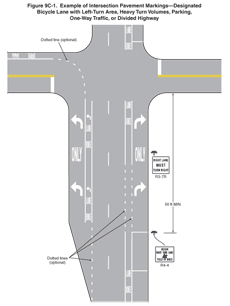
Section 9C.03 Marking Patterns and Colors on Shared-Use Paths
Option:
01 Where shared-use paths are of sufficient width to designate two minimum width lanes, a solid yellow line may be used to separate the two directions of travel where passing is not permitted, and a broken yellow line may be used where passing is permitted (see Figure 9C-2).
Figure 9C-2 Examples of Center Line Markings for Shared-Use Paths
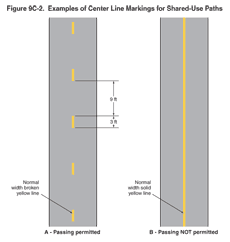
Guidance:
02 Broken lines used on shared-use paths should have the usual 1-to-3 segment-to-gap ratio. A nominal 3-foot segment with a 9-foot gap should be used.
03 If conditions make it desirable to separate two directions of travel on shared-use paths at particular locations, a solid yellow line should be used to indicate no passing and no traveling to the left of the line.
04 Markings as shown in Figure 9C-2 should be used at the location of obstructions in the center of the path, including vertical elements intended to physically prevent unauthorized motor vehicles from entering the path.
Option:
05 A solid white line may be used on shared-use paths to separate different types of users. The R9-7 sign (see Section 9B.12) may be used to supplement the solid white line.
06 Smaller size letters and symbols may be used on shared-use paths. Where arrows are needed on shared-use paths, half-size layouts of the arrows may be used (see Section 3B.20).
Section 9C.04 Markings For Bicycle Lanes
Support:
01 Pavement markings designate that portion of the roadway for preferential use by bicyclists. Markings inform all road users of the restricted nature of the bicycle lane.
Standard:
02 Longitudinal pavement markings shall be used to define bicycle lanes.
Guidance:
03 If used, bicycle lane word, symbol, and/or arrow markings (see Figure 9C-3) should be placed at the beginning of a bicycle lane and at periodic intervals along the bicycle lane based on engineering judgment.
Figure 9C-3 Word, Symbol, and Arrow Pavement Markings for Bicycle Lanes
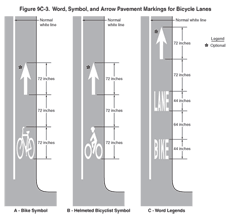
Standard:
04 If the bicycle lane symbol marking is used in conjunction with word or arrow messages, it shall precede them.
Option:
05 If the word, symbol, and/or arrow pavement markings shown in Figure 9C-3 are used, Bike Lane signs (see Section 9B.04) may also be used, but to avoid overuse of the signs not necessarily adjacent to every set of pavement markings.
Standard:
06 A through bicycle lane shall not be positioned to the right of a right turn only lane or to the left of a left turn only lane.
Support:
07 A bicyclist continuing straight through an intersection from the right of a right-turn lane or from the left of a left-turn lane would be inconsistent with normal traffic behavior and would violate the expectations of right- or left-turning motorists.
Guidance:
08 When the right through lane is dropped to become a right turn only lane, the bicycle lane markings should stop at least 100 feet before the beginning of the right-turn lane. Through bicycle lane markings should resume to the left of the right turn only lane.
09 An optional through-right turn lane next to a right turn only lane should not be used where there is a through bicycle lane. If a capacity analysis indicates the need for an optional through-right turn lane, the bicycle lane should be discontinued at the intersection approach.
10 Posts or raised pavement markers should not be used to separate bicycle lanes from adjacent travel lanes.
Support:
11 Using raised devices creates a collision potential for bicyclists by placing fixed objects immediately adjacent to the travel path of the bicyclist. In addition, raised devices can prevent vehicles turning right from merging with the bicycle lane, which is the preferred method for making the right turn. Raised devices used to define a bicycle lane can also cause problems in cleaning and maintaining the bicycle lane.
Standard:
12 Bicycle lanes shall not be provided on the circular roadway of a roundabout.
Guidance:
13 Bicycle lane markings should stop at least 100 feet before the crosswalk, or if no crosswalk is provided, at least 100 feet before the yield line, or if no yield line is provided, then at least 100 feet before the edge of the circulatory roadway.
Support:
14 Examples of bicycle lane markings at right-turn lanes are shown in Figures 9C-1, 9C-4, and 9C-5. Examples of pavement markings for bicycle lanes on a two-way street are shown in Figure 9C-6. Pavement word message, symbol, and arrow markings for bicycle lanes are shown in Figure 9C-3.
Figure 9C-4 Example of Bicycle Lane Treatment at a Right Turn Only Lane
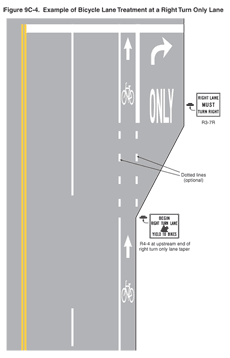
Figure 9C-5 Example of Bicycle Lane Treatment at Parking Lane into a Right Turn Only Lane
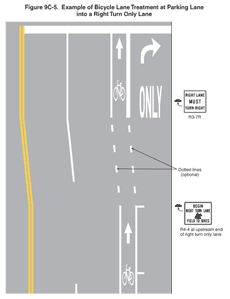
Figure 9C-6 Example of Pavement Markings for Bicycle Lanes on a Two-Way Street
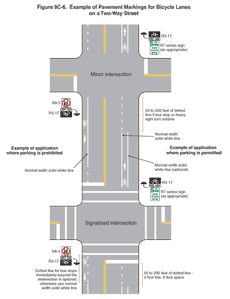
Section 9C.05 Bicycle Detector Symbol
Option:
01 A symbol (see Figure 9C-7) may be placed on the pavement indicating the optimum position for a bicyclist to actuate the signal.
Figure 9C-7 Bicycle Detector Pavement Marking
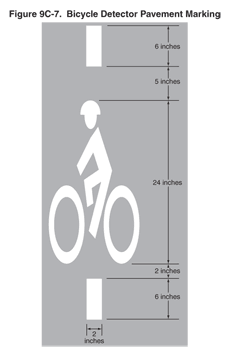
02 An R10-22 sign (see Section 9B.13 and Figure 9B-2) may be installed to supplement the pavement marking.
Section 9C.06 Pavement Markings for Obstructions
Guidance:
01 In roadway situations where it is not practical to eliminate a drain grate or other roadway obstruction that is inappropriate for bicycle travel, white markings applied as shown in Figure 9C-8 should be used to guide bicyclists around the condition.
Figure 9C-8 Examples of Obstruction Pavement Marking
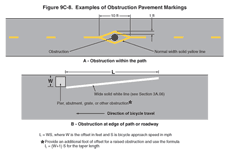
Section 9C.07 Shared Lane Marking
Option:
01 The Shared Lane Marking shown in Figure 9C-9 may be used to:
Figure 9C-9 Shared Lane Marking
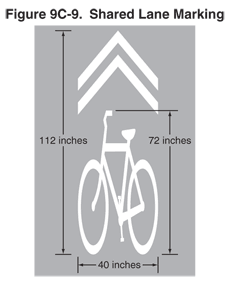
- Assist bicyclists with lateral positioning in a shared lane with on-street parallel parking in order to reduce the chance of a bicyclist's impacting the open door of a parked vehicle,
- Assist bicyclists with lateral positioning in lanes that are too narrow for a motor vehicle and a bicycle to travel side by side within the same traffic lane,
- Alert road users of the lateral location bicyclists are likely to occupy within the traveled way,
- Encourage safe passing of bicyclists by motorists, and
- Reduce the incidence of wrong-way bicycling.
Guidance:
02 The Shared Lane Marking should not be placed on roadways that have a speed limit above 35 mph.
Standard:
03 Shared Lane Markings shall not be used on shoulders or in designated bicycle lanes.
Guidance:
04 If used in a shared lane with on-street parallel parking, Shared Lane Markings should be placed so that the centers of the markings are at least 11 feet from the face of the curb, or from the edge of the pavement where there is no curb.
05 If used on a street without on-street parking that has an outside travel lane that is less than 14 feet wide, the centers of the Shared Lane Markings should be at least 4 feet from the face of the curb, or from the edge of the pavement where there is no curb.
06 If used, the Shared Lane Marking should be placed immediately after an intersection and spaced at intervals not greater than 250 feet thereafter.
Option:
07 Section 9B.06 describes a Bicycles May Use Full Lane sign that may be used in addition to or instead of the Shared Lane Marking to inform road users that bicyclists might occupy the travel lane.
